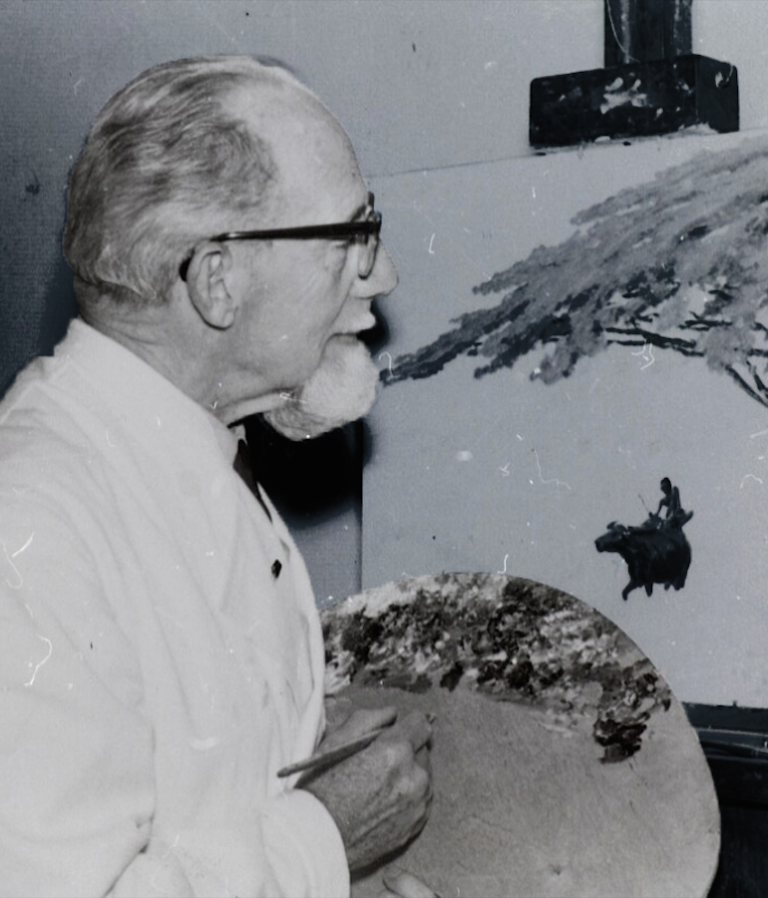Willem Jan Pieter van der Does was a Dutch painter, art illustrator, draftsman, and water-colorist associated with the East Indies impressionist movement.
Biography
Willem van der Does was born on 20 April 1889 in Rotterdam, Netherlands.[1] He was the son of an expat (probably a sea commander) working in the Dutch East Indies. Since his childhood, he had always been taught to become an artist by his family, in his youthful years he studied in de Rotterdam Academie van Kunst (now the Willem de Kooning Academy) and then continued his study privately.[2] He came to the Dutch East Indies around the year c.1918, and growing up there until he became a civil servant to survey the country. In this function he traveled all over the archipelago such as Surabaya, Batavia, Medan, Malang and Bandung.[1]
He participated in several group and solo exhibition in the Netherlands and Indonesia. He was also the first ever known Dutchmen to have traveled to Antarctica.[3] During his travel to Antarctica in 1923–1924, he made around 144 sketches for his book Storm, Ijs, en Walvisschen which describes his expedition and journey in exploring Antarctica.[4]
In 1936 van der Does participated in the 1936 Olympics event in Berlin. In this event he submitted a painting that he had created in the Dutch Indies titled “Towards the Unknown” (the subject are two explorers struggling against an Antarctic storm), the painting was exhibited in the Kaiserdamm hall, along with other submitted paintings. He received a bronze participation medal from the Olympics Committee.[5][6]
Van der Does was also a teacher. One of his students was the Indonesian painter Koempoel Sujatno (1912–1987). Van der Does collaborated with the impressionist painter Gerard Pieter Adolfs in the East Indies. Together, the pair created one of the first impressionist movements in East Indies (who brought and applied the Amsterdam impressionist movement). Works by the two sometimes have technical similarities.[7]
Van der Does’s works once had been presented to King Leopold III of Belgium and Queen Astrid of Sweden, and on the occasion of Queen Wilhelmina of the Netherlands‘s 50th birthday, the government of the Dutch East Indies presented her with a work by him. Many of his works had also been given to various government officials and other important people. These are the reasons why van der Does was often called by the East Indies government “the royal painter from the Indies”.[8]
Van der Does’s illustrations were widely used throughout the 1930s in Java and in 1950s in Holland. They illustrated some of the most important printed books,[7] that are usually a series of a translated and research book. An example is the Dutch translation of Richard Henry Dana Jr.‘s 1840 work Two Years Before the Mast. This book was translated into Dutch by the Holland-America Line ship’s commodore, Captain Pieter Verhoog,[9] a close friend of van der Does.[note 1] Van der Does was also a newspaper illustrator and editor in the East Indies and after he went back to the Netherlands he did many journalistic works for the local newspaper.
Van der Does went back to the Netherlands in 1946. His return was caused by the early Indonesian revolution era, when many foreign people were forced to leave the country. He continued his career as a painter in Holland, and often depicted daily life in the East Indies through his memory and sketches. In Holland he often painted scenes depicting Surabaya and Malang. He stayed in Schiedam; and in 1957, he and his family moved to his retirement house in Zeist.[10] He died on 3 February 1966 in Zeist, Netherlands.[1]
Van der Does told a Dutch journalist who interviewed him in his retirement apartment in Zeist the main reason why he would not go back to the East Indies. In a subtle and saddened old man voice he said,
If I close my eyes and think about the Indies, I always taught that it is the Indies I will never go back to, and can never go back, because the Indies that I know no longer exists.
Van der Does’s legacy is as a patronage for the East Indies impressionist movement. His works have been collected by Kings and Queens, and also by many other named collectors, museums, institutes, and galleries around the world including countries like the Netherlands, Indonesia, United States, Singapore, Germany, United Kingdom, France, Austria, Malaysia, and Hong Kong.
